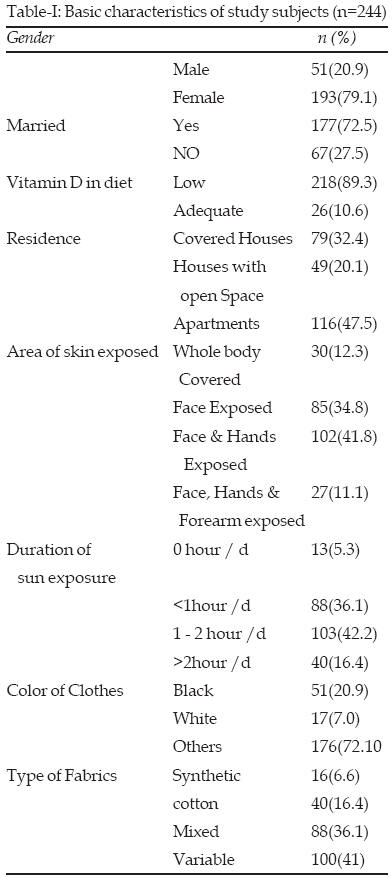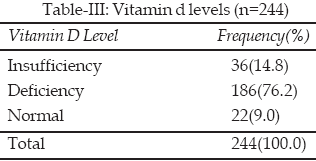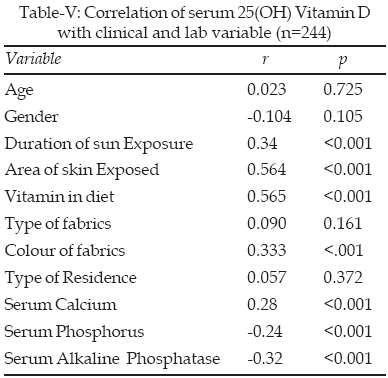|
|
||||
|
Published by : PROFESSIONAL MEDICAL PUBLICATIONS |
||||
|
ISSN 1681-715X |
||||
|
||||
|
- |
||||
|
ORIGINAL ARTICLE- |
||||
|
- |
||||
|
Volume 25 |
July - September 2009 |
Number 4 |
||
|
|
||||
|
|
||||
|
|
||||
|
Published by : PROFESSIONAL MEDICAL PUBLICATIONS |
||||
|
ISSN 1681-715X |
||||
|
||||
|
- |
||||
|
ORIGINAL ARTICLE- |
||||
|
- |
||||
|
Volume 25 |
July - September 2009 |
Number 4 |
||
|
|
||||
|
|
||||
Vitamin-D status in a Population of
healthy adults in Pakistan
Khalid Mahmood1, Syed Tehseen Akhtar2, Abu Talib3, Iftikhar Haider4
ABSTRACT
Objective: To determine the prevalence of hypovitaminosis D and its predictors in healthy adult Pakistanis. This study was conducted at various hospitals in Karachi from April 2007 to September 2007.
Methodology: In this study 244 healthy adults 16-62 years of age, visited hospital as an attendant of the patients and fulfilled the inclusion and exclusion criteria has been enrolled. After taking written consent a questionnaire regarding age, gender, occupation, duration of sun exposure, area of skin exposed, type of residence used, clothing and dietary habits were recorded. Serum 25-OH Vitamin D3 levels were determined by electrochemiluminescence method and Vitamin D deficiency was defined as a level <20µg/ml. serum calcium. Phosphorus and Alkaline Phosphatase were also measured in all of these subjects.
Results: Among 244 subjects ranging from 16-62 years, 193(79%) were female. Subjects were predominantly married (72%), mostly residing in apartments (47.5%) and most of them (41.8%) only exposed their face and hands while outdoor. Duration of sun exposure in majority was 1-2 hour /day (42%). Majority used clothes of variable colour (72%) and fabric (41%). One hundred and eighty six (76.2%) subjects had deficiency of Vitamin D and significantly correlated with duration of sunlight exposure, large area of skin exposed, vitamin D in diet consumed and colour of clothes worn. Vitamin D was significantly correlated negatively with serum Phosphorus and Alkaline Phosphatase whereas serum calcium correlated positively.
Conclusion: Prevalence of hypovitaminosis D among healthy Pakistanis is high and duration of sun exposure is the most common predictor of hypovitaminosis D.
KEY WORDS:
Hypovitaminosis D, Healthy subjects, Risk factors.Pak J Med Sci July - September 2009 Vol. 25 No. 4 545-550
How to cite this article:
Mahmood K, Akhtar ST, Talib A,Haider I. Vitamin-D status in a Population of Healthy Adults in Pakistan. Pak J Med Sci 2009;25(4):545-550.
1. Prof Khalid Mehmood
Prof of Medicine
2. Dr.Syed Tehseen Akhtar
Senior Registrar Medical Unit IV
3. Dr. Abu Talib
Associate Prof of Medicine
4. Dr.Iftikhar Haider
Assistant Prof of Medicine
1-4: Medical Unit IV
Dow University of Health Sciences,
Karachi Pakistan.
Correspondence
Dr. Syed Tehseen Akhtar
E-mail: drstakhtar@yahoo.com
* Received for Publication: March 17, 2009
* Accepted: July 16, 2009
INTRODUCTION
Epidemiological studies suggest that lower vitamin-D {25(OH) D} status is associated with a higher risk for osteoporotic fractures
1 and malignancy of breast, colon, ovary and prostate.2-4 Studies have reported that 25(OH) D deficiency is an unrecognized entity endemic in both children and adults in the United States.4 Once it was thought that vitamin D deficiency was a rarity in south Asia.5 In year 2000 a study conducted in healthy subjects in Delhi showed a prevalence of hypovitamin D to be 90 per cent6 and subsequently a number of studies from different parts of India showed widespread vitamin D deficiency in Indians of all age groups.7-9Furthermore multiple studies in different countries showed high prevalence of vitamin D deficiency in Asian population.
10-18 Little is known about the status of 25(OH) D in local population. There is no published data regarding the prevalence of vitamin D insufficiency in healthy adult local population. Because of the health risks associated with low levels of vitamin D, the primary objective of this study was to test the hypothesis that vitamin D deficiency (250HD level, <20 ng/mL)19-22 was prevalent among apparently healthy asymptomatic adult population.The secondary objective was to identify factors within adult lifestyle that represent predictors for hypovitaminosis D in the study participants.
METHODOLOGY
A cross-sectional multicentre study was conducted in different hospitals of Karachi, Pakistan from April, 2007 to September, 2007. Karachi is located at 24° N latitude and 67° E longitude with abundant sunshine throughout the year. There is no difference in sunshine during the period of field study that could substantially affect vitamin D status. In this study two hundred forty four (244) healthy adult subjects 16-62 years of age who came as attendants to their hospitalized patients were recruited.
The exclusion criteria were:
* Subjects with any signs and symptoms of vitamin D deficiency such as unexplained musculoskeletal pain and aches, generalized bone pain, bony deformities/tenderness, proximal myopathy.
* History of thyroid, parathyroid, adrenal or gonadal disease.
* History of any metabolic bone disease
* Malignancy
* Hepatic and Renal disease
* Malabsorption syndrome or history of gastrointestinal resection, chronic diarrhea.
* Hysterectomy
* Diabetes Mellitus
* History of taking medicines which affect the vitamin D status e.g. calcium supplements, vitamin D supplements, Antiepileptics, estrogen and progesterone.
* Pregnancy and lactation
* Immobility for more than one-week.
A questionnaire was administered to determine the age, sex, occupation, details of duration of exposure to sun light in previous month, area of skin exposed, type of residence used to live, clothing and dietary habits.
Fasting blood samples were drawn in the morning by disposable syringes through venepuncture and a maximum of 5ml of blood was taken. The serum was separated after complete centrifugation of blood samples within two hours of venepuncture, collected in tubes and preserved at a temperature of 20
oC until analyzed.The serum 25-OHD levels were used to evaluate the vitamin D status. The serum 25-OHD concentrations were measured by Electrochemiluminescence method from Agha Khan University Lab. The reference range for 25-OHD was = or > 30 ng/ml as normal, vitamin D deficiency was defined as serum 25-OHD levels < 20 ng/ml while a level between 20.1-29.9 ng/ml was defined as insufficiency.
The serum levels of calcium, phosphate and alkaline phosphatase activity were measured using routine laboratory methods to get additional information about vitamin D status. The food composition database used in Pakistan does not contain vitamin D. Furthermore study subjects were not able to recall quantity of vitamin D containing foodstuff taken by them. Due to these limitations exact estimation of dietary intake of vitamin D was not possible.
Analysis was performed with SPSS version 15. Continuous variables were expressed as mean ±SD whereas discrete variables were expressed as percentages and analyzed by chi-square test where needed. A p-value <0.05 was considered as statistically significant. A Pearson Correlation analysis between Vitamin D and other variables was done and p-value <0.01 was considered statistically significant.

RESULTS
The prevalence of hypovitaminosis D among healthy subjects was high. Characteristics of subjects and descriptive statistics are shown in Table-I & II respectively.

Subjects ranged in age from16-62 years with a mean of 33.62±12.64 years. Among 244 subjects 193(79%) were female. Subjects predominantly were married 177(72.5%), mostly residing in apartments (47.5%) and when outdoor most of them only exposed hands and face (41.8%). Duration of sun exposure in majority was 1-2 hours (42%). Majority of subjects used clothes of variable fabrics (41%) with variable colors (72%).Regarding dietary habits most of the participants consumed food poor in vitamin D content 218(89.3%) whereas 26(10.7%) subjects had adequate amount of food rich in vitamin D content. One hundred eighty six (76.2%) subjects of the study population had deficiency of vitamin D (<20ng), 36 (14.8%) has insufficiency (>20<30) and 22 (9%) has normal level of vitamin D (Table-III).

Statistically there was no difference between male and female regarding vitamin D level (Table-IV).

Table-V Shows the correlation between serum 25 (OH) Vitamin D levels and clinical and laboratory variables. Vitamin D levels were not significantly correlated with age, marital status, gender difference, type of residence and type of cloth fabrics whereas there were significant correlation between vitamin D and longer duration of sunlight exposure, area of skin exposed, vitamin D content in diet and color of clothes. Among the laboratory variables vitamin D significantly correlated negatively with serum phosphorus and alkaline phosphatase whereas serum calcium correlated positively.

DISCUSSION
Prevalence of Hypovitaminosis D was surprisingly high (76%) among healthy subjects in Pakistanis residing in Karachi despite abundant sunlight throughout the year. This result is endorsed by many previous studies
10-12,18,23-28 in countries having adequate sunshine. Turkey, India, Lebanon, Jordan, China, Saudi Arabia, Iran and Tunisia have high prevalence ranging from 44-95%. In some of these studies the high prevalence of hypovitaminosis was attributed to dietary factors,12,18,24 multiparity,24,28 clothing factor,12,24 limitation and avoidance of sunlight exposure28 and air pollution10 which prevents enough Ultra Violet B rays penetration.In local population avoidance of sun light due to fear of darkening of skin and covering of whole body religiously or only exposing face and hands traditionally especially in female subjects when going outdoor were the main attributing factors. Male subjects also avoid sun exposure not only due to high temperature in summer season in this part of the world but also have misconception regarding harmful effects of sunlight and unawareness regarding the source of Vitamin D. Effect of sunlight on Vitamin D status has been well documented and confirms the importance of sunlight exposure in the synthesis of vitamin D
29,30 Sunlight exposure was the most important determinant of Vitamin D levels in the study population. Area of skin exposed and duration of sunlight exposure strongly correlated with Vitamin D levels in this study as shown similarly by other studies.10,12,27,28,31 As dark skin requires more sun exposure than less pigmented skin to produce similar amount of vitamin D30 it is not surprising that hypovitaminosis D is so prevalent in this country.Dietary factor was another determinant of the study regarding high prevalence as most of our participant were consuming low amount of vitamin D rich food True estimation of vitamin D intake was not possible owing to unawareness regarding quantity of consuming diet by participants and unavailability of food composition database for Vit D used in Pakistan. Furthermore there is no Vitamin D food fortification in Pakistan and no history of use of calcium and Vitamin D supplements among study subjects were also contributing in high prevalence but some previous studies
10,25 showed no such association whereas other studies27,28 showed significant correlation.Type of fabric has shown no significant correlation in study population whereas colour of the cloth has. It has previously been found that Ultra Violet rays are attenuated most by black wool and least by white cotton.
36 In this country a significant percentage of women wear black clothes traditionally for pardah while outdoor.Air pollution is another attributing factor
10of hypovitaminosis D. Karachi is one of the highly polluted city of the world so the pollution could be an attributing factor in study subjects but this was beyond our study scope to evaluate pollution effects.Finally it is concluded that local healthy population also has a high prevalence of vitamin D deficiency and the main contributing factor is limited sun exposure due to avoidance of sunlight and covering of the whole body except face and hands while outdoor. Other factors may also play a minor role. To combat this situation it is recommended to create awareness to increase sunlight exposure and high intake of vitamin D rich food at mass level and starting of Vitamin D food fortification program at government level.
Limitation of the study: We had several limitations. Study was done at one point of time. We were not able to calculate the daily dietary intake of vitamin D due to several reasons. Duration of sun exposure was based on recall rather than actual. We also ignored the overcast and rainy days during study period. Furthermore we did not check the serum Paratharmone levels due to limitation of resources.
REFERENCES
1. Rucker D, Allan JA, Fick GH, Hanley DA. Vitamin D insufficiency in a population of healthy western Canadians. CMAJ 200;166(12):1517-24. Erratum in: CMAJ 2002;167(8):850.
2. Garland CF, Garland FC, Shaw EK, Comstock GW, Helsing KJ, Gorham ED. Serum 25- Hydroxy Vitamin D and colon cancer. Eight year prospective study. Lancet 1989;18:1176-78.
3. Grant WB. An ecologic study of the role of solar UV-B radiation in reducing the risks of cancer using cancer mortality data, dietary supply data and latitude for European countries. In: MF Holick,ed.Biologic effects of light 2001.Boston:Kluwer Acdemic Publishing 2002;267-6.
4. Holick MF. Sunlight and Vitamin D for the bone health and prevention of autoimmune diseases, cancers and cardiovascular disease. Am J Clin Nutr 2004;80:1678S-88S.
5. Hodgkin P, Kay OM, Hine PM, Lumb QA, Stanbury SW. Vitamin D deficiency in Asian at home and in Britain. Lancet 1973;2:167-72.
6. Goswami R, Qupta N, Ooswamal D, Marwaha RK, Tandon N, Kochupillai N. Prevalence and significance of low 25 hydroxyvitamin D concentrations in healthy subjects in Delhi. Am J CUn Nutr 2000;72:472-75.
7. Harinarayan CV, Ramalakshmi T, Prasad UV, Sudhakar D, Srinivasarao PV, Sarma KV, et al. High prevalence of low dietary calcium, high phytate consumption, and vitamin D deficiency in healthy south Indians. Am J Clin Nutr 2007;55:1062-7.
8. Marwaha RK, Tandon N, Reddy DRHK, Aggarwal R, Singh R, Sawhney RC, et al. Prevalence and significance of low 25hydroxyvitamin D concentrations in healthy subjects in Delhi. Am J Clin Nutr 2005;82:477-82.
9. Goswami R, Mishra SK, Kochupillai N. Prevalence & potential significance of vitamin D deficiency in Asian Indians. Indian J Med Res 2008;127:229-238.
10. Hashemipour S, Larijani B, Adibi H, Javadi E, Sedaghat M, Pajouhi M. Vitamin D deficiency and causative factors in the population of Tehran BMC Public Health. 2004;4(1):38.
11. Du X, Greenfield H, Fraser DR. Vitamin D deficiency and associated factors in adolescent girl in Beijing. Am J Clin Nutr 2001;74:494-500.
12. Alagol F, Shihadeh Y, Boztepe H. Sunlight exposure and vitamin D in Turkish women. J Endocrinol Invest 2000;23:173-77.
13. Sedrani SH. Low 25-Hydroxy vitamin D and normal serum calcium concentrations in Saudi Arabia: Riyadh region. Ann Nutr Metab 1984;28:181185.
14. Sedrani SH, Elidrissy AW, Arabi KM. Sunlight and vitamin D status in normal Saudi subjects. Am J Coo Nutr 1983;38:129-132.
15. Azizi F, Rais-Zadeh F, Mir Said Ghazi A. Vitamin D deficiency in a group of Tehran Population. Research in Medicine 2000;4:291-303.
16. Taha S, Dost S, Sedrani S. 25-hydroxy vitamin D and total calcium extra ordinarily low plasma concentrations in Saudi mothers and their neonates. Pediatr Res 1984;18:739-741.
17. Fonseca V, Tongia R, el-Hasmi M. Exposure to sunlight and vitamin D deficiency in Saudi Arabian women. Postgrad Med J 1984;60:589-591.
18. Goswami R, Gupta N, Goswami D, Marwaha RK, Tandon N, Kochupillai N. Prevalence and significance of low 25 Hydroxy vitamin D concentrations in healthy subjects in Dehli. Am J Clin Nutr 2000;72:422-75.
19. Brunvand L, Shah SS, Bergstrom S, Haug E. Vitamin D deficiency in pregnancy is not associated with obstructed labor. A study among Pakistani women in Karachi. Acta Obstet Gynecol Scand 1998;77:303-6.
20. Mezquita-Raya P, Munoz-Torres M, Luna JD, Luna V, Lopez-Rodriguez F, Torres-Vela E, et al. Relation between Vitamin D Insufficiency, Bone Density, and Bone Metabolism in Healthy Postmenopausal Women. JBMR. 2001;16:1408.
21. Gloth FM, Gundberg CM, Hollis BW, Haddad IG, Tobin JD. Vitamin D deficiency in homebound elderly persons. LAMA 1995;274:683-1686.
22. Webb AR, Pilbeam C, Hanafin N, Holick MF. An evaluation of the relative Contributions of exposure to sunlight and of diet to the circulating concentrations of 2S-hydroxyvitamin D in an elderly nursing home population in Boston. Am J Clin Nutr 1990;51:1075-1081.
23. Sachan A, Gupta R, Das V. High prevalence of vitamin D deficiency among pregnant women and their newborns in northern India. Am J Clin Nutr 2005;81:1060-1064.
24. Gannage-Yared MH, Chemali R, Yaacoub N, Halaby G. Hypovitaminosis D in a sunny country: relation to lifestyle and bone markers. J Bone Miner Res 2000;15:18561862.
25. Mishal AA. Effects of different dress styles on vitamin D levels in healthy young Jordanian women. Osteoporos Int 2001;12:931-935.
26. Al Faraj S, Al Mutairi K. Vitamin D deficiency and chronic low back pain in Saudi Arabia. Spine 2003;28:177179.
27. Moussavi M, Heidarpur R, Aminorroaya A. Prevalence of vitamin D deficiency in Isfahani high school students in 2004. Horm Res 2005;64:144148.
28. Meddeb N, Sahli H, Chahed M. Vitamin D deficiency in Tunisia. Osteoporos Int 2005;16:180183.
29. Bouillon R. Vitamin D: Photosynthesis, metabolism, and action to clinical applications. In: De Groot L, Jameson JL, Burger HG. (eds) Endocrinology, 3rd edn. Saunders, Philadelphia, 2001;10091028.
30. Saraiva GL, Cendoroglo MS, Ramos LR. Influence of ultraviolet radiation on the production of 25 hydroxyvitamin D in the elderly population in the city of Sao Paulo (23 degrees 342 S), Brazil. Osteoporos Int 2005;16:16491654.
31. Islam MZ, Akhtaruzzaman M, Lamberg-Allardt C. Hypovitaminosis D is common in both veiled and nonveiled Bangladeshi women. Asia Pac J Clin Nutr 2006;15:81-87.
32. Vieth R. Vitamin D supplementation, 25-hydroxyvitamin D concentrations, and safety. Am J Clin Nutr 1999;69:842856.
33. Matsuoka LY, Wortsman J, Dannenberg MJ. Clothing prevents ultraviolet-B radiation-dependent photosynthesis of vitamin D3. J Clin Endocrinol Metab 1992;75:1099-1103.
HOME | SEARCH | CURRENT ISSUE | PAST ISSUES
Professional
Medical Publications
Room No. 522, 5th Floor, Panorama Centre
Building No. 2, P.O. Box 8766, Saddar, Karachi - Pakistan.
Phones : 5688791, 5689285 Fax : 5689860
pjms@pjms.com.pk